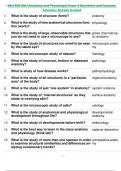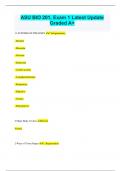Asu bio 201 - Study guides, Class notes & Summaries
Looking for the best study guides, study notes and summaries about Asu bio 201? On this page you'll find 40 study documents about Asu bio 201.
Page 2 out of 40 results
Sort by
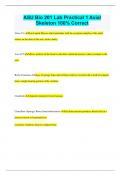
-
ASU Bio 201 Lab Practical 1 Axial Skeleton 100% Correct
- Exam (elaborations) • 12 pages • 2024
- Available in package deal
-
- $8.99
- + learn more
ASU Bio 201 Lab Practical 1 Axial Skeleton 100% Correct Atlas (C1) has Lateral Masses which articulate with the occipital condyles of the skull; rotates on the dens of the axis; lacks a body. Axis (C2) allows rotation of the head via the dens (odontoid process); dens is unique to the axis. Body (Centrum) mass of spongy bone and red bone marrow covered with a shell of compact bone; weight-bearing portion of the vertebra. Canaliculi channels running between lacunae. Cancellous...
ASU BIO 201 (Anatomy and Physiology) Exam 1 Questions and Accurate Solutions Already Graded

-
ASU bio 201 final exam Questions And Answers With Verified Solutions
- Exam (elaborations) • 20 pages • 2024
- Available in package deal
-
- $7.99
- + learn more
12 - how many cranial nerves? 2 effects of dual innervation - Antagonistic effects oppose each other: pupillary dilator and constrictor muscle, heart slowed down or speeded up Cooperative effects seen when 2 division act on different effectors to produce a unified effect 3 routes of sympathetic innervation - Spinal nerve route: effectors in body wall are innervated by sympathetic fibers that exit a ganglion by the gray ramus and travel through spinal nerves Sympathetic route: effectors in ...
ASU Bio 201 Bundled Exams Questions and Answers Multiple Versions (2024/2025) (Complete and Accurate)
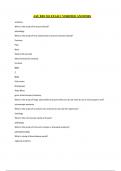
-
ASU BIO 201 EXAM 1 VERIFIED ANSWERS
- Exam (elaborations) • 20 pages • 2024
-
Available in package deal
-
- $10.49
- + learn more
ASU BIO 201 EXAM 1 VERIFIED ANSWERS anatomy What is the study of structure (form)? physiology What is the study of how anatomical structures function (work)? Previous Play Next Rewind 10 seconds Move forward 10 seconds Unmute 0:01 / 0:15 Full screen Brainpower Read More gross (macroscopic) anatomy What is the study of large, observable structures that you do not need to use a microscope to see? microscopic anatomy What is the study of structures too small ...

-
ASU BIO 201 FINAL EXAM VERIFIED SOLUTIONS
- Exam (elaborations) • 20 pages • 2024
-
Available in package deal
-
- $9.99
- + learn more
ASU BIO 201 FINAL EXAM VERIFIED SOLUTIONS 12 ️how many cranial nerves? 2 effects of dual innervation ️Antagonistic effects oppose each other: pupillary dilator and constrictor muscle, heart slowed down or speeded up Cooperative effects seen when 2 division act on different effectors to produce a unified effect 3 routes of sympathetic innervation ️Spinal nerve route: effectors in body wall are innervated by sympathetic fibers that exit a ganglion by the gray ramus and travel thr...
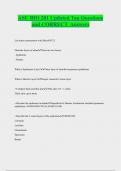
-
ASU BIO 201 Updated Top Questions and CORRECT Answers
- Exam (elaborations) • 16 pages • 2024
-
- $7.99
- + learn more
List terms synonymous with Skin123 Describe layers of skinThere are two layers: - Epidermis - Dermis What is Epidermus Layer?Outer layer of stratified squamous epithelium What is Dermis Layer?Deeper connective tissue layer • Compare thick and thin skinThin skin: 0.5 - 1-2mm Thick skin: up to 6mm

-
ASU BIO 201: EXAM 3 Questions and 100% Correct Verified Answers
- Exam (elaborations) • 36 pages • 2024
-
- $13.49
- + learn more
3 kinds of muscle tissue skeletal, cardiac, smooth major purpose of muscle converting chemical energy in ATP --> mechanical energy of motion muscle functions -movement of: whole body, body parts, organ contents -stability: maintain posture and prevent mvmt. -communication: speech, facial expressions and writing -control of openings and passageways: sphincters -body heat production
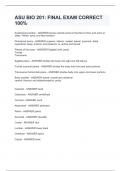
-
ASU BIO 201: FINAL EXAM CORRECT 100%
- Exam (elaborations) • 14 pages • 2024
-
Available in package deal
-
- $12.99
- + learn more
Anatomical position - ANSWER person stands erect w/ feet flat on floor and arms at sides. Palms, eyes, and face forward Directional terms - ANSWER superior, inferior, medial, lateral, proximal, distal, superficial, deep, anterior and posterior vs ventral and dorsal Planes of the body - ANSWER Sagittal (mid, para) Frontal Transverse Sagittal plane - ANSWER divides the body into right and left halves Frontal (coronal) plane - ANSWER divides the body into front and back portions T...
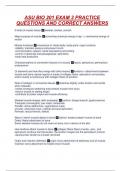
-
ASU BIO 201 EXAM 3 PRACTICE QUESTIONS AND CORRECT ANSWERS
- Exam (elaborations) • 18 pages • 2024
-
Available in package deal
-
- $9.99
- + learn more
3 kinds of muscle tissue skeletal, cardiac, smooth Major purpose of muscle converting chemical energy in atp --> mechanical energy of motion Muscle functions -movement of: whole body, body parts, organ contents -stability: maintain posture and prevent mvmt. -communication: speech, facial expressions and writing -control of openings and passageways: sphincters -body heat production Characterizations of connective tissues of a muscle fascia, epimysium, perimysium, endomysium Ct elements and...

That summary you just bought made someone very happy. Also get paid weekly? Sell your study resources on Stuvia! Discover all about earning on Stuvia

